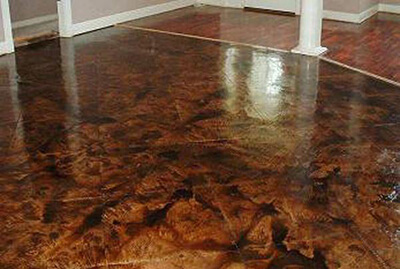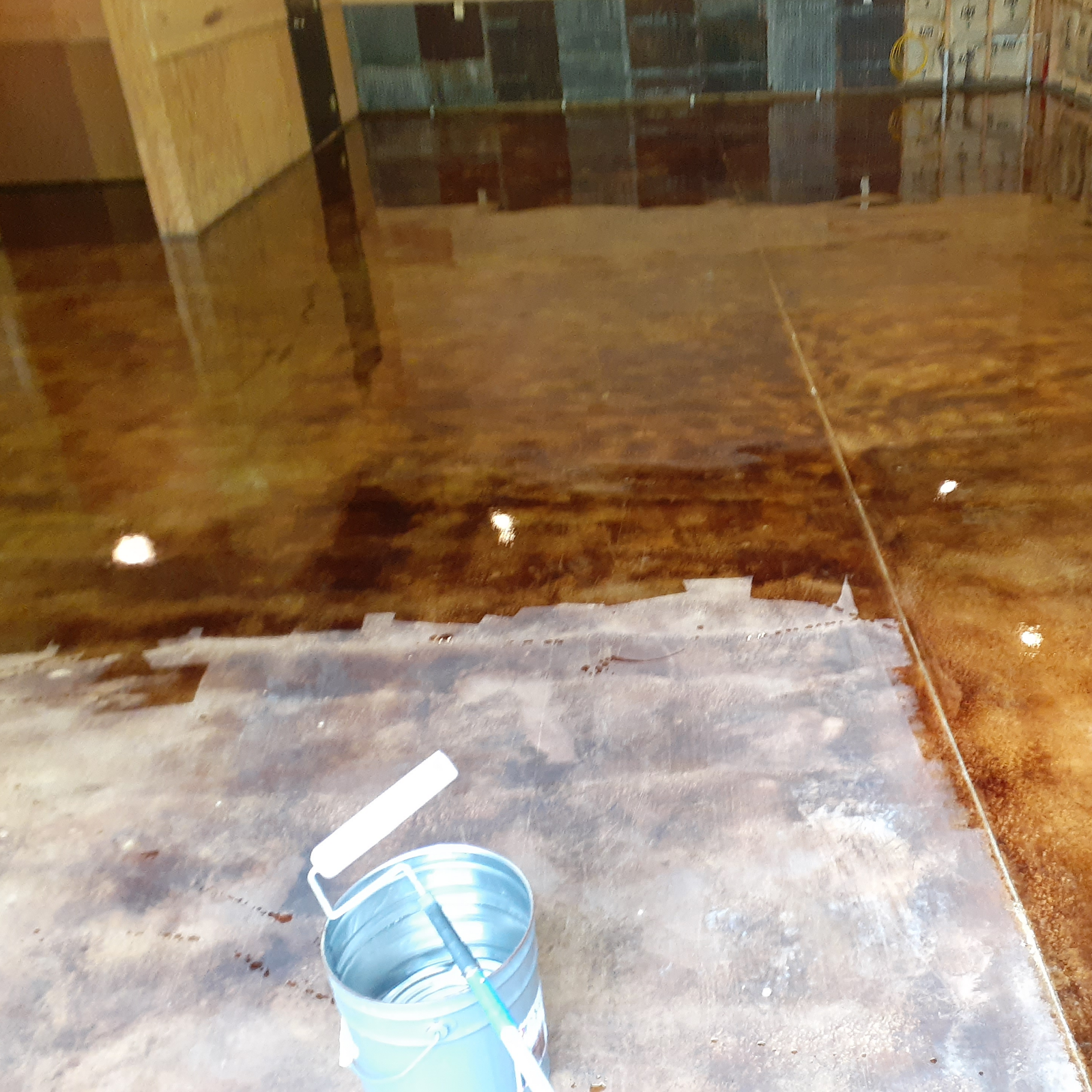Comprehending the Series Of Services Offered in Flooring: Highlighting Stained Concrete Techniques
Stained concrete has emerged as a compelling floor covering alternative for different spaces. Its versatility lies in the option in between acid and water-based discolorations, each providing unique aesthetics. Proper prep work and continuous maintenance are vital to assure its durability and appearance. As the need for ingenious floor covering solutions grows, recognizing the nuances of discolored concrete methods might open brand-new possibilities for both residential and commercial environments. What one-of-a-kind benefits might this flooring alternative offer a job?
The Fundamentals of Stained Concrete
Stained concrete functions as a functional floor covering alternative that combines longevity with visual charm. This floor covering technique involves using a specifically created stain to the concrete surface, which permeates and modifies the shade of the material. The process not only boosts the visual elements of concrete yet also supplies the advantage of securing it from deterioration. Stained concrete can accomplish a vast variety of looks, from earthy tones to lively tones, making it suitable for various style styles.
Proper preparation of the concrete surface area is important for ideal outcomes. This might include cleansing, grinding, or etching to guarantee the stain adheres successfully. Furthermore, the application process usually involves utilizing devices such as sprayers or brushes to attain consistent insurance coverage. After staining, a sealer is frequently used to improve durability and maintain the vibrancy of the color. Eventually, discolored concrete supplies an appealing and lasting floor covering option for household and commercial spaces alike.
Sorts of Stains: Acid vs. Water-Based

In comparison, water-based discolorations offer a broader range of shades and are simpler to apply. They do not react chemically with concrete but instead give a surface color - stained concrete austin. Water-based discolorations are reduced in unpredictable natural substances (VOCs), making them much more environmentally friendly and appropriate for indoor jobs. While they might not give the same deepness of shade as acid stains, their versatility and simplicity of usage make them appealing for numerous applications. Eventually, the option relies on the project's requirements, wanted visual appeals, and place
Methods for Staining Concrete
The methods for discoloring concrete differ significantly in between acid and water-based techniques. Acid staining entails a chemical reaction that develops unique, variegated colors, while water-based stains supply a wider scheme and simpler application. Recognizing these procedures is important for accomplishing the preferred aesthetic in concrete flooring.
Acid Staining Refine
Acid staining supplies a vibrant way to improve the visual allure of concrete surface areas. This procedure involves using a blend of water, hydrochloric acid, and pigments to the concrete, which reacts chemically to produce lively, transparent colors. The concrete surface has to be extensively cleaned and prepped to ensure optimal adhesion. As soon as used, the acid stain permeates the concrete, developing distinct marbled impacts as it responds with the lime in the concrete. After the preferred shade establishes, the surface is counteracted and rinsed to stop the reaction. A sealer is applied to shield the surface and boost sturdiness. Acid staining not just transforms the appearance of concrete however additionally supplies a long-lasting option for decorative floor covering.
Water-Based Staining Benefits
Exactly how can water-based staining elevate the aesthetic and useful high qualities of concrete surfaces? Water-based discolorations use a versatile option for boosting concrete, offering vivid color choices while assuring ecological safety. Unlike acid discolorations, water-based alternatives pass through the surface, permitting for also color distribution and a series of finishes, from matte to glossy. Furthermore, they are reduced in unpredictable organic compounds (VOCs), making them less unsafe to indoor air high quality. Their fast drying out time promotes faster project completion, while their resistance to fading makes sure durable beauty. Water-based stains can likewise enhance the concrete's toughness and resistance to discolorations, making them an ideal choice for both residential and commercial applications. Ultimately, they offer a sustainable, appealing remedy for numerous concrete surface areas.
Style Opportunities With Stained Concrete
Stained concrete deals a series of style possibilities that can enhance any click for source space. Techniques such as color variant, numerous surface area completing choices, and custom-made style patterns enable for distinct and individualized floor covering options. These components not just boost aesthetics yet additionally add to the overall performance of the concrete surface.
Shade Variant Techniques
While exploring the style possibilities of tarnished concrete, color variant techniques play a crucial role in improving both visual allure and performance. These methods enable for the development of unique patterns and results that can change an easy concrete surface area right into a visually striking component of an area. Alternatives such as acid staining, which reacts chemically with the concrete, produce abundant, translucent tones that simulate natural rock. Water-based spots supply a more comprehensive color scheme and permit even more control in style. Moreover, layering different discolorations can produce deepness and dimension, offering a customized appearance. By incorporating color variant techniques, developers can attain varied styles, from rustic to modern, making sure that discolored concrete fits perfectly right into any type of layout scheme.
Surface Area Finishing Options
The exploration of color variant techniques establishes the phase for taking into consideration surface ending up options, which significantly influence the general appearance and functionality of tarnished concrete. Different surfaces can enhance the visual charm and resilience of the surface. Typical choices consist of matte, satin, and shiny finishes, each offering an unique aesthetic result. Matte finishes provide find out here now a subtle, underrated style, while satin finishes strike a balance between shine and functionality, making them preferred for residential and business rooms. Shiny surfaces, on the other hand, produce a high-shine look, improving color vibrancy and light reflection. Furthermore, surface treatments such as polishing or sealing even more improve durability, making these completing options necessary factors to consider in making useful and aesthetically attractive discolored concrete floors.
Customized Design Patterns
How can custom design patterns boost the allure of discolored concrete? By integrating special styles, stained concrete can transform ordinary floor covering right into a striking visual statement. Custom patterns, such as geometric forms, detailed themes, or organic designs, permit for customization, making areas feel customized and welcoming. Customers can pick from a range of strategies, consisting of saw cuts, patterns, or overlays, to accomplish desired results. In addition, integrating multiple shades with different stain techniques boosts the depth and dimension of the patterns. These style possibilities not just improve visual charm but additionally enhance the worth of property or commercial rooms. Eventually, custom layout patterns offer a possibility for imagination, setting discolored concrete aside from typical flooring alternatives.
Preparing Your Concrete Surface
Correct preparation of the concrete surface area is necessary for accomplishing an effective stained coating. This process starts with comprehensive cleansing to eliminate dust, grease, and any kind of other pollutants. A stress washer or a floor scrubber can properly eliminate these materials, guaranteeing a tidy slate for staining. After cleaning, it is important to fix any cracks or flaws in the concrete. This can be accomplished utilizing a concrete patching substance, which should be enabled to cure fully before proceeding.
Once the surface area is clean and fixed, grinding or fining sand may be required to create a smooth, even appearance. This step improves the concrete's capacity to soak up the stain evenly. Finally, a concrete etcher can be applied to open the pores of the surface area, permitting much better adhesion of the stain (stained concrete austin). By adhering to these prep work actions, the resulting tarnished concrete will certainly show a more vibrant and enduring surface
Upkeep and Treatment for Stained Concrete
Keeping discolored concrete is essential for preserving its appearance and longevity after the initial preparation and application of stain. Routine cleaning is very important; sweeping or vacuuming to get rid of dust and particles protects against scratches and dullness. For much deeper cleansing, a mild pH-neutral detergent blended with water can be made use of, followed by thorough rinsing to prevent deposit buildup.
Securing discolored concrete is another essential maintenance step, as it protects the surface from stains and moisture. Depending on the sealant type, reapplication may be required every one to three years. Additionally, avoiding harsh chemicals and abrasive devices aids preserve the stability of the stain.
For outside stained concrete, it is recommended to clear snow or ice quickly to stop damages from freeze-thaw cycles. Generally, constant care warranties that tarnished concrete preserves its dynamic shade and structural security in time, making it a lasting floor covering choice.

Cost Considerations for Stained Concrete Floor Covering
When evaluating the price of discolored concrete floor covering, prospective house owners often question the different elements that influence pricing. Trick considerations include the dimension of the location to be covered, the complexity of the style, and the kind of stain made use of. Standard staining methods tend to be extra economical, while detailed patterns or several colors can significantly increase prices.

Geographic location is one more variable, as costs can differ extensively from one area to an additional. Recurring upkeep expenses must be factored in, as sealants and protective finishings may be required over time to protect the aesthetic and resilience of the discolored concrete.
Frequently Asked Questions
Can Stained Concrete Be Applied Over Existing Floor Covering?
The concern of whether stained concrete can be used hop over to here over existing flooring is frequently asked. Typically, it is feasible, offered the underlying surface area is clean, secure, and appropriate for proper attachment of the discolored concrete.
How Lengthy Does the Staining Process Take?
The staining procedure commonly takes a few hours to a complete day, depending upon the size of the location and the complexity of the style. Treating might call for extra time before the surface area is fully functional.
Is Stained Concrete Suitable for Outdoor Usage?
Stained concrete is without a doubt suitable for outdoor use, as it holds up against various weather. Its sturdiness and visual allure make it a popular option for outdoor patios, sidewalks, and driveways, enhancing both functionality and visual rate of interest.
Can I Adjustment the Shade of Stained Concrete Later On?
The capacity to change the color of stained concrete later relies on different aspects, consisting of the original stain type and surface area prep work. Consulting a specialist can give guidance on potential choices and results for color modification.
Are There Eco-Friendly Options for Stained Concrete?
The query concerning environmentally friendly choices for stained concrete reveals a growing interest in sustainable structure techniques. Several companies now provide low-VOC spots and ecologically friendly sealers, guaranteeing aesthetic allure while minimizing ecological influence.